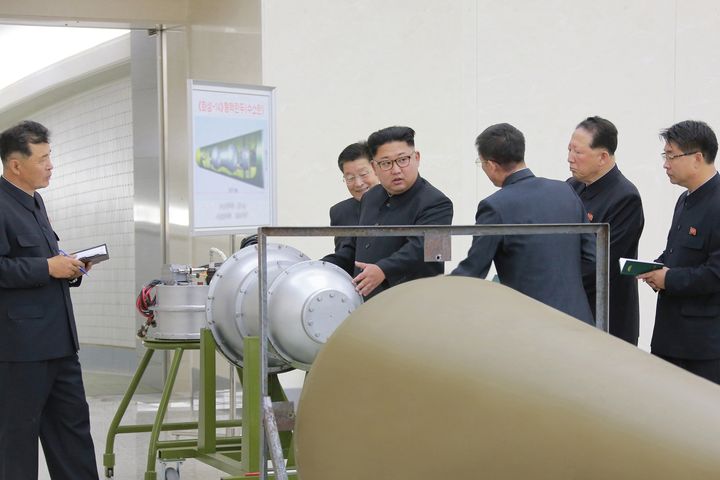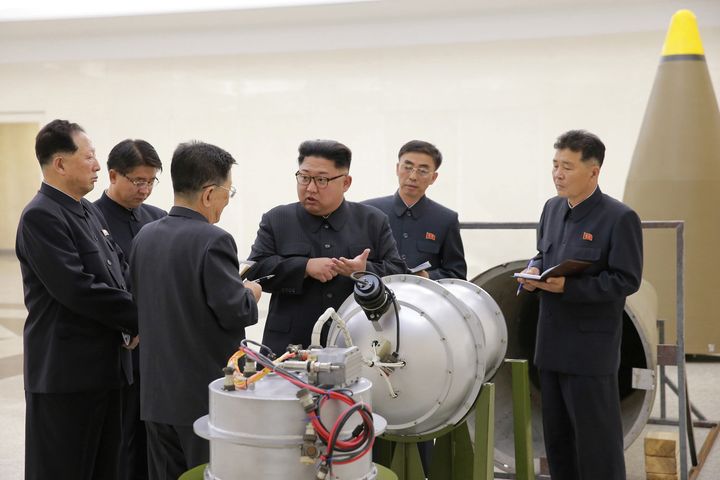US Secretary of Defense James Mattis has warned North Korea that any provocation will be met with a “massive military response” after the outcast state said it has successfully tested a nuclear weapon that can be loaded onto a long-range missile.
In the most outspoken response since the secretive state conducted its sixth and most powerful test on Sunday, Mattis said he does not want “total annihilation” of North Korea but that President Donald Trump had been briefed on each of the “many military options” that had the capability to do that.
“We made it clear that we have the ability to defend ourselves and our allies, South Korea and Japan, from any attack and that our agreements with our allies are iron-clad,” he outside the White House.
The test drew swift international condemnation, with Trump describing North Korea as a “rogue nation” and saying its actions “continue to be very hostile and dangerous to the United States”.

Trump initially said on Twitter: “Their words and actions continue to be very hostile and dangerous to the United States.
“North Korea is a rogue nation which has become a great threat and embarrassment to China, which is trying to help but with little success.”
He also appeared to take the unlikely step of publicly criticising its ally in the region, South Korea.
“South Korea is finding, as I have told them, that their talk of appeasement with North Korea will not work, they only understand one thing!,” he said in another tweet.
When asked later if the United States would attack North Korea, he said “we’ll see” , and tweeted the US is “considering, in addition to other options, stopping all trade with any country doing business with North Korea”.
In the UK, Prime Minister Theresa May said the test posed an “unacceptable further threat to the international community”.
Foreign Secretary Boris Johnson condemned North Korea’s “reckless” nuclear weapon test and stressed that “all options are on the table”.

A magnitude 6.3 earthquake shook the country on Sunday, suggesting it had detonated its sixth and most powerful nuclear test device.
The quake rocked hours after Pyongyang said it had developed an advanced hydrogen bomb that possesses “great destructive power”.
The tremor, which Japan said was a nuclear test, struck 45 miles northwest of Kimchaek, where previous tests have been conducted.
There was no independent confirmation that the detonation, which drew swift international condemnation, was a hydrogen bomb rather than a less powerful atomic device.
But such a move would be a direct challenge to Trump, who hours earlier had talked by phone with Japanese Prime Minister Shinzo Abe about the “escalating” nuclear crisis in the region.
Trump has said North Korea would meet “fire and fury” if it continued to escalate its nuclear threat.
The 6.3 magnitude recorded by the US Geological Survey represents North Korea’s most powerful detonation yet, which one expert said could support its claims to have developed a hydrogen bomb.
“The power is 10 or 20 times or even more than previous ones,” Said Kune Y. Suh, a nuclear engineering professor at Seoul National University. “That scale is to the level where anyone can say a hydrogen bomb test.”
A US official who studies North Korea’s military and politics told Reuters that seismic data on the tremors was being analysed, although the location suggested another nuclear test.
The official, who spoke on the condition of anonymity, said it was too early to determine if a test, if there was one, supported the North’s claim that has succeeded in developing a thermonuclear weapon, “much less one that could be mounted on an [intercontinental ballistic missile] and re-enter Earth’s atmosphere without burning up”.
The hydrogen bomb report by North Korea’s official KCNA news agency comes amid heightened regional tension following Pyongyang’s two tests of intercontinental ballistic missiles (ICBM) in July that potentially could fly about 6,200 miles, putting many parts of the mainland United States within range.
Under third-generation leader Kim Jong Un, North Korea has been pursuing a nuclear device small and light enough to fit on a long-range ballistic missile, without affecting its range and making it capable of surviving re-entry into the Earth’s atmosphere.
Witnesses in the Chinese city of Yanji, on the border with North Korea, said they felt a tremor that lasted roughly 10 seconds, followed by an aftershock.
China said it had detected a second, 4.6 magnitude quake with near identical coordinates eight minutes later.
“I was eating brunch just over the border here in Yanji when we felt the whole building shake,” Michael Spavor, director of the Paektu Cultural Exchange, which promotes business and cultural ties with North Korea.
“It lasted for about five seconds. The city air raid sirens started going off.”